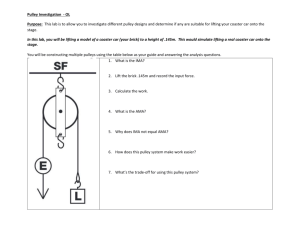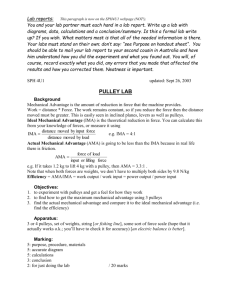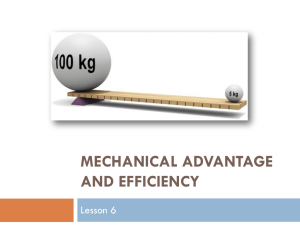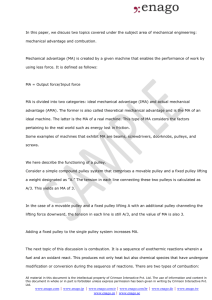FVCC Physics Laboratory
advertisement
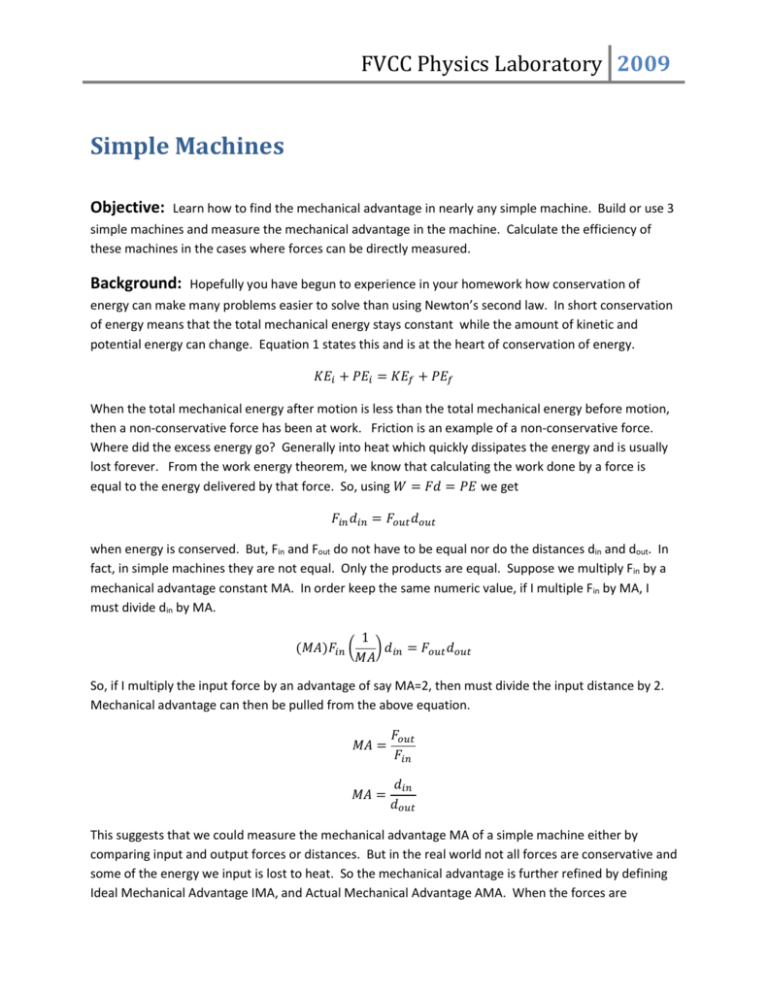
FVCC Physics Laboratory 2009 Simple Machines Objective: Learn how to find the mechanical advantage in nearly any simple machine. Build or use 3 simple machines and measure the mechanical advantage in the machine. Calculate the efficiency of these machines in the cases where forces can be directly measured. Background: Hopefully you have begun to experience in your homework how conservation of energy can make many problems easier to solve than using Newton’s second law. In short conservation of energy means that the total mechanical energy stays constant while the amount of kinetic and potential energy can change. Equation 1 states this and is at the heart of conservation of energy. 𝐾𝐸𝑖 + 𝑃𝐸𝑖 = 𝐾𝐸𝑓 + 𝑃𝐸𝑓 When the total mechanical energy after motion is less than the total mechanical energy before motion, then a non-conservative force has been at work. Friction is an example of a non-conservative force. Where did the excess energy go? Generally into heat which quickly dissipates the energy and is usually lost forever. From the work energy theorem, we know that calculating the work done by a force is equal to the energy delivered by that force. So, using 𝑊 = 𝐹𝑑 = 𝑃𝐸 we get 𝐹𝑖𝑛 𝑑𝑖𝑛 = 𝐹𝑜𝑢𝑡 𝑑𝑜𝑢𝑡 when energy is conserved. But, Fin and Fout do not have to be equal nor do the distances din and dout. In fact, in simple machines they are not equal. Only the products are equal. Suppose we multiply Fin by a mechanical advantage constant MA. In order keep the same numeric value, if I multiple Fin by MA, I must divide din by MA. (𝑀𝐴)𝐹𝑖𝑛 ( 1 ) 𝑑 = 𝐹𝑜𝑢𝑡 𝑑𝑜𝑢𝑡 𝑀𝐴 𝑖𝑛 So, if I multiply the input force by an advantage of say MA=2, then must divide the input distance by 2. Mechanical advantage can then be pulled from the above equation. 𝑀𝐴 = 𝐹𝑜𝑢𝑡 𝐹𝑖𝑛 𝑀𝐴 = 𝑑𝑖𝑛 𝑑𝑜𝑢𝑡 This suggests that we could measure the mechanical advantage MA of a simple machine either by comparing input and output forces or distances. But in the real world not all forces are conservative and some of the energy we input is lost to heat. So the mechanical advantage is further refined by defining Ideal Mechanical Advantage IMA, and Actual Mechanical Advantage AMA. When the forces are FVCC Physics Laboratory 2009 conservative, than MA is equal to IMA. If the forces are both non-conservative and conservative, then we have AMA. Since it is in the force that this distinction shows up, we have a method of determining IMA vs. AMA. 𝐼𝑀𝐴 = 𝑑𝑖𝑛 𝑑𝑜𝑢𝑡 𝐴𝑀𝐴 = 𝐹𝑜𝑢𝑡 𝐹𝑖𝑛 So the efficiency of the simple machine is simple the ratio of these factors. 𝐸𝑓𝑓 = 𝐴𝑀𝐴 100 𝐼𝑀𝐴 In this lab we will always be able to measure the input distance 𝑑𝑖𝑛 and output distance 𝑑𝑜𝑢𝑡 for various machines. Doing this will give us a direct measure of the MA of a simple machine. In two cases we will also be able to measure the input force 𝐹𝑖𝑛 and output force 𝐹𝑜𝑢𝑡 thereby getting an AMA estimate. So what is a simple machine? It is a mechanical aid which allows us to magnify the force we need to move something by increasing the distance we apply our input force to. Examples of simple machines are many including the following list: 1. 2. 3. 4. 5. Ramp Scissors Screw jack Lever arm Pulley system Hydraulic jack 6. 7. 8. 9. Bicycle gears Pump Ratchet Etc. Equipment: Pulley machine Pulley Frame 2-100lb scales 1 double pulley 2 single pulleys ¼ inch rope Ramp machine Pasco track End pulley for track String Weight hanger 3-beam balance Weight set Lab support for track Rolling cart Hydraulic jack machine Hydraulic jack Ruler Tape measure FVCC Physics Laboratory 2009 Procedure: In this lab we will investigate 3 simple machines. For two of these machines (ramp and pulley) we can measure the efficiency of the machine. A) The ramp….. B) The hydraulic jack….. C) The pulley system…. measure IMA and AMA, calculate efficiency measure IMA measure IMA and AMA, calculate efficiency A) The Ramp. Lifting a heavy object can be made a lot easier if you use a ramp. Test this simple concept by finding the mass needed to “lift” one of the frictionless carts up an incline. The setup is shown in Figure 1. Figure 1. The Ramp simple machine. 1. 2. 3. 4. Weigh the cart Attach the cart to the hanging weights with a string routing it over the pulley as shown. Add weights to the weight hanger until the cart barely moves up the plane. Take the ratio of the masses to find AMA 𝑔𝑚𝑐𝑎𝑟𝑡 𝑚𝑐𝑎𝑟𝑡 𝐴𝑀𝐴 = = 𝑔𝑚𝐻𝑎𝑛𝑔𝑒𝑟 𝑚𝐻𝑎𝑛𝑔𝑒𝑟 5. Measure the distance the hanging weights had to fall to lift the cart to the top of the ramp. (i.e. measure dout and din) 6. Calculate the IMA and this simple machines efficiency. 7. Estimate the error in your result for efficiency. See the lab guide on errors. FVCC Physics Laboratory 2009 B) The Hydraulic jack. Hydraulic jacks can lift an amazing amount of weight. To get an idea of the mechanical advantage, measure how far you move your hand while pumping the jack handle compared to the distance the jack actually rises. Estimate your error. Is this IMA or AMA? C) The pulley. The pulleys used in this lab came from the hardware section at the local Lowe’s home improvement store. You can easily use these inexpensive pulleys for many applications. In this lab we will hook up the three arrangements shown in Figure 2 and measure the AMA. Reading the figure left to right, the first figure (a) is simply done to ensure that the scales are measuring the same values. The second figure (b) is using one pulley to multiply the force and the third figure (c) uses a double pulley. In the two case where pulleys are used as simple machines, (the second two figures) measure AMA. To measure IMA you need to measure the distance the rope moves. Since the rope with significantly stretch in from the load, we cannot get an accurate distance in. So, we will not measure IMA. D) As an extra if you have time, remove the pulleys and simple use the rope through the eyebolts. There is more friction in this case (Use figure b) but it is surprisingly good. Measure IMA and AMA for this case. Figure 2. Diagrams of the pulley configurations. FVCC Physics Laboratory 2009 What’s in your report: Here is a check list of items to address in your laboratory report. 1) Measured AMA and IMA for the ramp. 2) Calculated efficiency for the ramp. 3) Estimated error for the data and subsequent calculations such as AMA and IMA. Use the propagation of errors outlined in the lab webpage. 4) Measured AMA for the two pulley systems Rope Stretch data Note that the rope used with the pulley stretches significantly under stress. If you measure the input distance on the pulley sections, you need to estimate the rope for stretch. Here is some data from the rope estimating stretch. Position 48.9 CM Load 0 initial delta 48 47.5 47.2 46.9 46.5 46 45.9 stretch per cm 0 L= KG 0.9 1.4 1.7 2 2.4 2.9 3 1 2 3 4 6 8 13 0.9 1.4 1.7 2 2.4 2.9 3 Stretch/length 0.01125 0.0175 0.02125 0.025 0.03 0.03625 0.0375 80 2 pulley 4 pulley expected expected stretch stretch 2.7 4.5 4.2 7 5.1 8.5 6 10 7.2 12 8.7 14.5 9 15 cm cm cm cm cm cm cm
